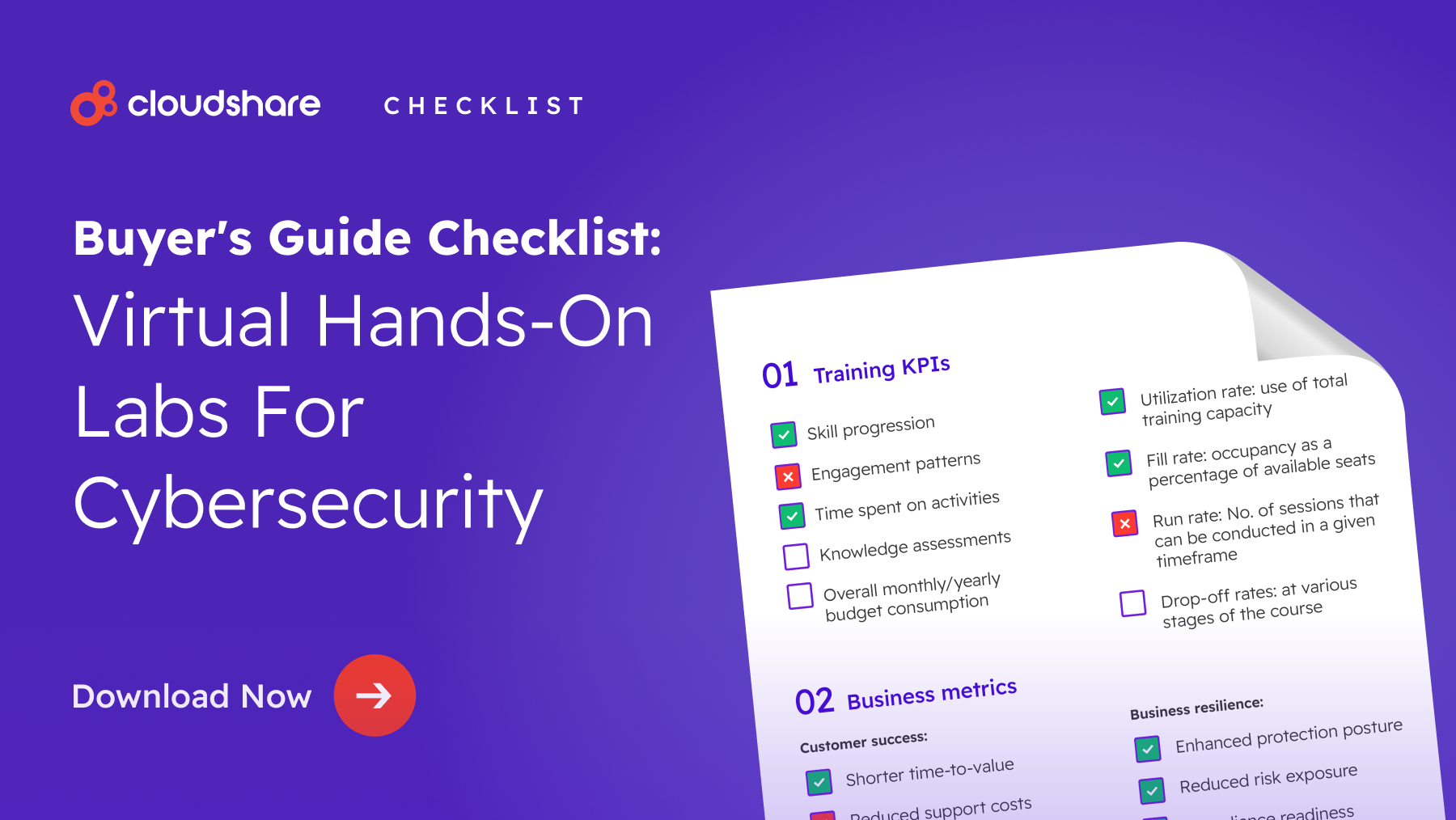
Workplace training is integral to any company, regardless of industry or size. It ensures employees and business partners are always in line with the company’s goals and operations, as well as increase efficiency and lower the chance of mistakes.
Successful managers who know how to create a training program can reduce employee turnover and optimize the onboarding process. Many use virtual training labs to maximize their benefit from such training programs.
However, creating an effective training course in business takes work. You need to think about several things before you get started. For example:
- Does the program fall in line with the company’s overall goals?
- Is the material relevant to what the participants need?
- What should you do after the course to continue improving it?
In addition to these, there are other granular considerations you need to make. We’ve listed seven steps to simplify this process to create an effective virtual employee training program below.
8 Steps To Create An Effective Virtual Training Program
Creating an employee training program requires alignment between the employee’s needs and the company’s overarching objectives. If you’re wondering how to make virtual training effective while achieving alignment, here’s how:
Step 1: Choose the Right Training Platform
Before you can create online training for your employees, you need to make sure your infrastructure is capable of supporting said training. That means selecting the right training platform. Ideally, you’ll want software that’s easy to use for both instructors and participants.
Your solution of choice must also be scalable, capable of easily adjusting to changing resource demands. Accessibility is a must for online training as well, as is analytics functionality. After all, you need to be able to monitor participants — both to identify potential bottlenecks in your training material and to proactively reach out to anyone who appears to be struggling.
Lastly, you may want to consider seeking out a training solution that supports hands-on learning. As we’ve mentioned on more than one occasion, interactive training is considerably more engaging than other training methods. Rather than expecting employees to sit back and passively absorb knowledge, you provide them with the opportunity to practice that knowledge and apply it in the development of practical skills.
Step 2: Define the Objectives of Your Training Program
Once you have your training software up and running you may be tempted to immediately dive into developing your employee education. That would be a mistake, however — not to mention a significant waste of resources. Instead, what you need to do is take a step back and consider why you need this training program in the first place.
Some of the most common reasons include:
- Lost productivity. Employees simply aren’t working as efficiently and effectively as they once were. This could occur on an organizational level, or it may impact only a single department.
- Lack of compliance. Regulatory compliance and security require more than ticking off a few checkboxes. You need to make sure your employees actually have some understanding of the regulations to which you must adhere — and that requires comprehensive training.
- New product launches. If your company recently released new software (or added features to existing software), you need to make sure your sales team, support team, and customer success team all understand how the new additions work. Otherwise, they cannot effectively do their jobs.
- Operational changes. If your company has recently undergone a shift in business objectives or operations, you may need to refresh or rework your existing training — which naturally will require that employees undergo it again.
- Training mandates. Self-explanatory. If the government requires your business to begin training employees in a particular discipline or field, you’ve little choice but to comply.
- New software. Lastly, if your business incorporates a new software solution or platform, there’s bound to be at least a slight learning curve. It’s your responsibility to help employees get past that curve and use the software effectively.
Step 3: Have the Participants’ Needs in Mind
We all know the saying, “happy employees are productive employees.” Companies should take this to heart when they’re looking at creating a virtual training program.
After all, nobody wants to sit in a stuffy classroom (virtual or otherwise!) listening to mind-numbing lectures that don’t relate to their job or interests.
Corporate training increases employees’ productivity while making them happier and more confident in their abilities. Moreover, if you’re implementing a training session, your employees will want to know what’s in it for them—and why they need to take time out of their busy schedules. So, ensuring that coursework aligns with their workplace responsibilities is critical.
In addition, you need to consider what type of training works best for your workplace. For example, some employees might have more demanding tasks and prefer virtual instructor-led training. On the other hand, some employees prefer the liveliness of an in-person session, so that they might prefer classroom-based exercises. To accommodate the differing needs, consider a blended learning approach.

Step 4: Spell Out Parameters for Success
To create a truly effective virtual training program, you must map the success metrics to the learning objectives.
In other words, what should participants gain when they finish the training program? Having a specific definition guides how you will develop the training program, and any assessment measures at the end will test for these objectives. Companies can effectively measure their investment in their employee training and determine if it’s really paying off.
Learning objectives can come in the form of textbook knowledge or practical skills. Either way, use the acronym S.M.A.R.T. to define them:
- Specific (non-ambiguous and apparent)
- Measurable (easy to assess)
- Achievable (realistic)
- Relevant (important for the success of its participants)
- Time-bound (point of success is clearly defined)
Example:
Mediocre KPI: “I want to see if employees are more productive after the session.”
S.M.A.R.T KPI: “I will measure the output-per-worker-hour to estimate if our employees are more productive after the session.”
Step 5: Create An Outline For the Training Program
Creating an effective employee virtual training program can be challenging. There are so many variables to consider:
- How much time is needed?
- What should be included?
- How can you make sure it’s engaging?
The key is to create an outline for the course before you write anything else. It allows you to visualize your end goal and determine the necessary steps.
Write down everything that goes into creating this program—from goals and objectives to content creation and delivery methods. It’ll prevent you from forgetting something important later on in the process.
Also, this is only useful once you’re done with the research phase, as it ensures you haven’t missed crucial details. Once you have this framework, you can start writing the materials for each course section.
Step 6: Develop the Training Course Materials
There are many different tools to help you generate instructional materials. Office programs are helpful for writing outlines and notes. Slideshows are useful for instructor-led segments of the class.
These days, more intuitive tools like learning management systems (LMS) integrate with training makers to deliver consistent and lively training experiences.
So, work with experts in your market to determine the most important skills and knowledge your employees need to do their jobs effectively.
Step 7: Implement the Training Program
It’s important to note that how you deliver workplace education matters as much as what the content entails. An LMS can help you when it comes to assigning, delivering, and tracking the progress of employee coursework.
Above all, consider using eLearning tools to capture the advantages of online-based training. Some third-party services offer SaaS (Software-as-a-Service) training, which is accessible from any location at any time.
Online courses are also much more scalable and less expensive to implement than traditional approaches, though you could miss out on the hands-on experience that a classroom provides. So, find a balance using a blended learning methodology if you consider it suitable.
Step 8: Monitor Employee Progress Continuously
Business training design is not a “set it and forget it” project.
After each session, try to find out how to improve the coursework and delivery methods.
Obtain feedback from participants after each class in the form of a survey and use the data to make adjustments. Soon, you’ll see tangible benefits in your business’s overall performance thanks to your training program.
Take Advantage of Cloud Training with CloudShare
Administering virtual training can be tricky, but with the right tool, you can easily offer consistent and engaging experiences.
CloudShare is one such tool that can offer employee training and monitor their progress in one dashboard—and ensure you meet regulatory and compliance requirements.
If the convenience, accessibility, and affordability of cloud sales training sound attractive to you, then don’t start another business education program without it.
Whether you need proof of concept presentations, sandboxing environments, or corporate training services, CloudShare has you covered.
If you’d like to take it for a spin, book a demo with us and discover how you can meet your training goals.
This post was originally published on December 2020 and updated on December 27, 2022.

This Blog was published in December 2022 and updated in April 2024.



